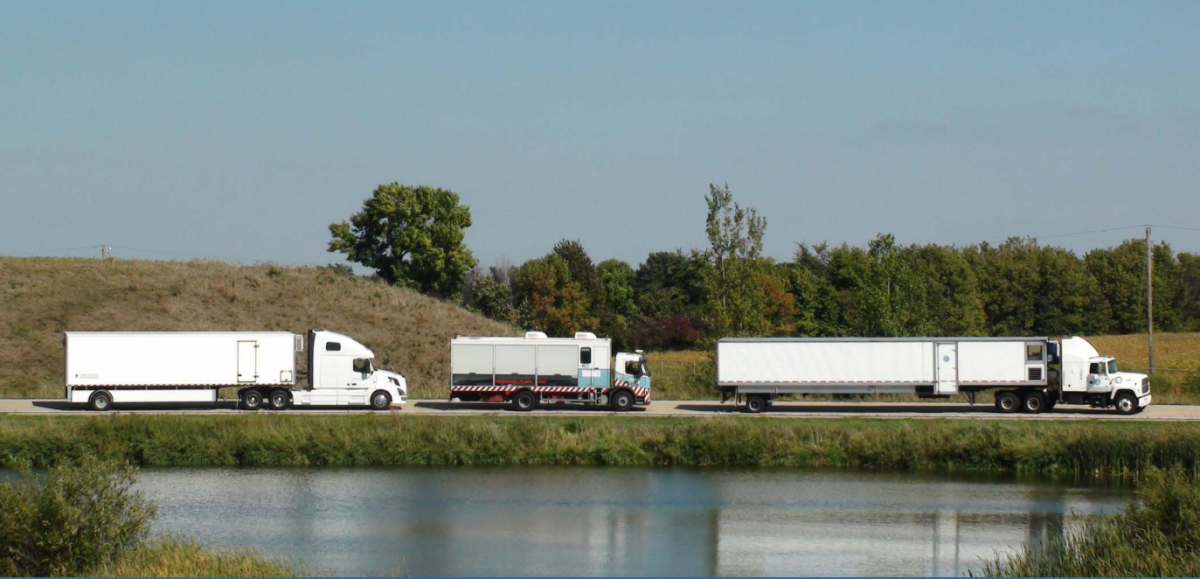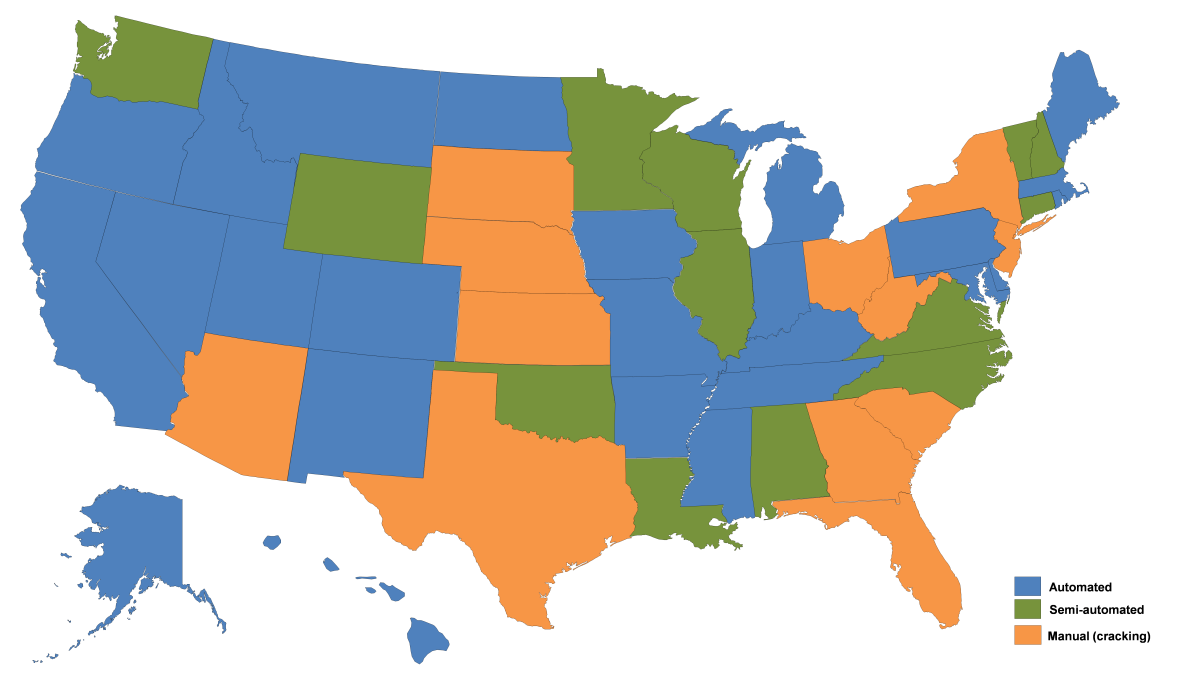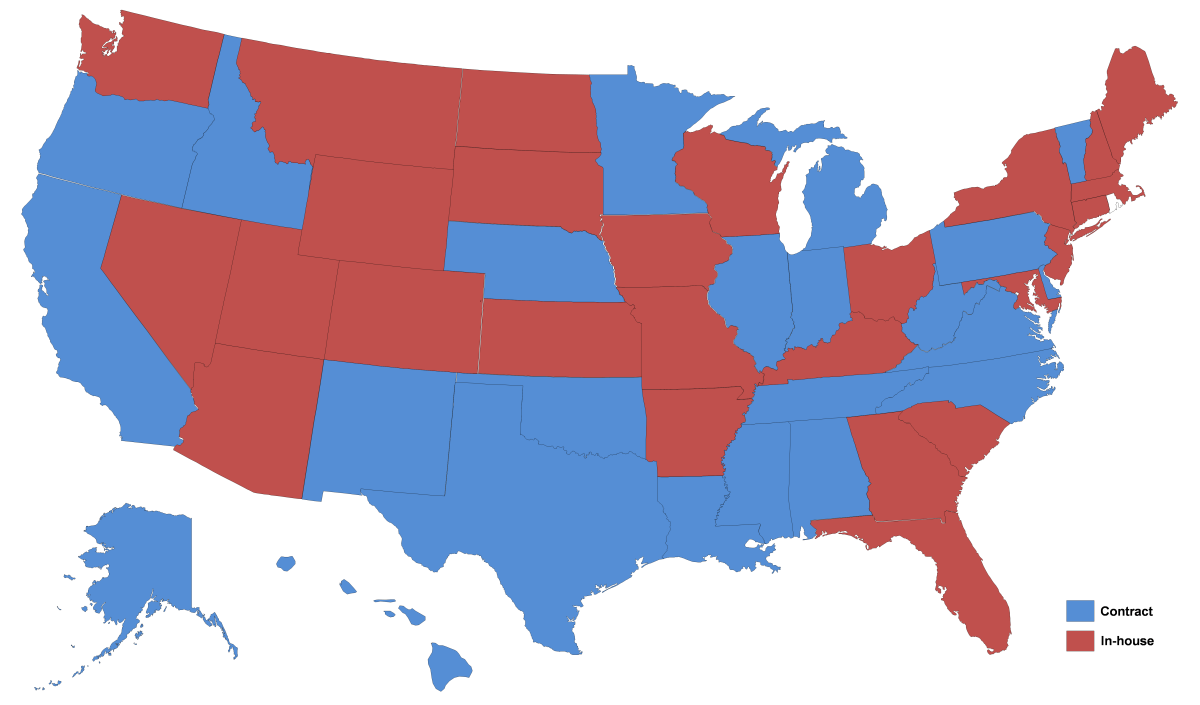Prepared by Zhongren Wang, Caltrans
1. Introduction
A typical output from a Pavement Management System (PMS) is a list of recommended pavement improvement projects. These PMS-recommended projects need to be reviewed, adjusted, and finalized before possible funding commitment. In the review process, the relationships between the recommended projects and the currently programmed, under-construction, and as-built projects must be identified and closely examined to avoid gaps, overlaps, or inappropriate treatments. Presented in a tabular format, such a list of projects does not lend itself to easy identification of the necessary relationships. A visualization environment is necessary.
At the California Department of Transportation (Caltrans), the importance of such a visualization environment for project review has long been recognized. In the past, Caltrans pavement engineers manually drew horizontal bar charts using Microsoft Excel® for such purposes. Led by Tom Pyle, a Caltrans Supervising Transportation Engineer, the manually-drawn bar charts were further developed and automated in the process of implementing the Caltrans pavement management system, called PaveM. Present automation was developed through contract with the University of California Pavement Research Center (UCPRC). The product is called H-Chart, short for Highway chart. The following is a brief description of the H-chart.
2. H-Chart
An H-chart, as shown in Figure 1, provides the visualization of all past, current, and future projects for one direction of a specific route within one county, and one district. Caltrans divides its jurisdiction into 12 districts up and down California. For example, the H-chart shown in Figure 1 is dedicated for the northbound direction of route 101 in Del Norte County, in Caltrans District 01.
In Figure 1, the x-axis shows the county odometer and the y-axis shows Year. Projects are shown as hatched and colored horizontal bars. The project limits (the start and end locations) are located on the x-axis by means of county odometer values. These county odometer values are computed from the state odometer associated with the start and end of a project. The year of the project is indicated by its vertical location on the chart.
An H-chart displays projects with four different states, namely (1) Completed or as-built, (2) Under Construction, (3) Programmed, and (4) PMS- or PaveM-Recommended. These project states are indicated in the chart by different cross-hatching patterns. In an H-chart, the earliest known as-built projects are displayed at the bottom of page, followed by the programmed and under construction projects, and finally the recommended future projects at the top. The thick dashed horizontal line in Figure 1 separates the recommended future projects from the rest.
Each project shown in Figure 1 is also identified by a budget group. There are four budget groups for typical pavement projects in Caltrans. These include (1) Highway Maintenance (HM) Preventive, (2) HM Corrective programs, (3) Capital Program Maintenance (CAPM), and Rehabilitation. Each budget group is associated with a specific color. For example, Rehabilitation group is associated with red color.
Each project also has a label that contains such information as: treatment type, lane number or “All”, Expenditure Authorization (EA) number and Post-Mile (PM) limits. The contents of the label are configurable when the H-charts are generated. Use the label in the upper left corner of Figure 1 “CinPlePrecyc-All 01-2T12LA-T-II” as an example, this label signifies that this particular project is a PaveM-recommended project with a Cold-in-Place-Recycling treatment for “All” lanes. The EA number of 01-2T12LAT is a temporary one (for future potential project with no funding commitment), because it ends with a capital letter ‘T’. As a rule, an EA number with funding commitment ends with a numeric value in Caltrans. For example, the label shown in Figure 1 “Med OL-All 01-49940” means a “Medium Overlay” treatment for all lanes with an EA number of “01-49940”. The “-II” following the EA number refers to the PaveM running Scenario that corresponds to the title of the chart.
Together with the depicted projects, pavement type and pavement condition information is also respectively shown at the top and bottom of the sample H-chart shown in Figure 1. The cracking and IRI values are based on the latest available pavement condition survey. The label for ‘crack%’, such as “0.3/2:0.7” shown at the lower left corner of Figure 1 means that the average wheel path cracking across all lanes from PM 0 to PM 4.4 is 0.3%, and the highest cracking percentage is 0.7%, occurring in lane number 2.
H-Charts are generated automatically with minimal post-processing in Excel®. A total of 1066 H-charts can be generated across the entire California pavement network based on the available district, county, route, and route direction combinations. The detailed breakdowns of these H-charts for each Caltrans district are tabulated in Table 1. Readers are encouraged to try out this web-based H-Chart generation application on their own. The website is: http://dev.ucprc.ucdavis.edu/PaveM-rViewer/.
Table 1. The Number of H-Charts for Each District and the State
| District |
1 |
2 |
3 |
4 |
5 |
6 |
7 |
8 |
9 |
10 |
11 |
12 |
| Number |
60 |
80 |
132 |
175 |
84 |
120 |
98 |
88 |
38 |
99 |
56 |
36 |
| Total |
1066 |

Figure 1 A Sample H-Chart (Please click on figure to see larger version)
3. How to Use an H-Chart?
With pavement condition, as-built projects, programmed projects, and PaveM-recommended projects visualized in one chart, an H-chart provides an effective working environment for pavement engineers to evaluate, compare, adjust, and select projects for future programming and planning purposes. An H-chart makes it easy to identify overlapping projects in schedule, or in limits. For example, project 01-49940 and 01-08080 shown in Figure 1 overlap in schedule. It may not make sense to apply a medium overlay treatment on top of a thin overlay treatment that just applied a year ago. An H-chart also facilitates the easy identification of project gaps. For example, the segment from PM 20 to 25 has not been treated ever since the year of 1994. Why is there such a long hiatus for a flexible pavement to be treated? Is it because of too low a traffic volume? Is it due to short of funding? Or is it because the project history is not completely shown by the H-chart? Answers to these types of questions may well help better plan for the current and future projects.
In addition, an H-chart may help better justify a project by showing pavement condition and the proposed projects simultaneously. The H-chart shown in Figure 1 may be carried to the field to help adjust project limits on the scene; or to a project public hearing meeting to make project briefing and public education more effective.
4. Summary
As a visualization tool for project review, H-charts greatly facilitate the project selection process. It is a powerful working environment to identify project gaps, overlaps, and justify candidate projects and adjust/select potential projects. It can be used in office, or in the field. It is also instrumental for management briefing or public education purposes. It is a great feature for a PMS to possess to better support the decision making process for pavement project selection.
For more information, please contact Zhongren Wang at: Zhongren.Wang@dot.ca.gov
 Continuous deflection testing devices at MnROAD test facility for an FHWA study on “Network Level Pavement Structural Evaluation”. From left to right: Greenwood TSD, Euroconsult Curviameter, and Applied Research Associates (ARA) RWD. [Picture Source: “Network Level Pavement Structural Evaluations – A Way forward,” Presented by Nadarajah Sivaneswaran (FHWA) at National Pavement Evaluation Conference 2014]
Continuous deflection testing devices at MnROAD test facility for an FHWA study on “Network Level Pavement Structural Evaluation”. From left to right: Greenwood TSD, Euroconsult Curviameter, and Applied Research Associates (ARA) RWD. [Picture Source: “Network Level Pavement Structural Evaluations – A Way forward,” Presented by Nadarajah Sivaneswaran (FHWA) at National Pavement Evaluation Conference 2014]


